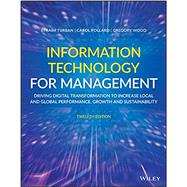Information Technology for Management, 12 Edition provides students with a comprehensive understanding of the latest technological developments in IT and the critical drivers of business performance, growth, and sustainability. Integrating feedback from IT managers and practitioners from top-level organizations worldwide, the newest edition of this well-regarded textbook features thoroughly revised content throughout to present students with a realistic, up-to-date view of IT management in the current business environment.
The text offers a flexible, student-friendly presentation of the material through a pedagogy that is designed to help students with different learning styles easily comprehend and retain information. This blended learning approach combines visual, textual, and interactive content—featuring numerous real-world case studies of how businesses use IT to increase efficiency and productivity, strengthen collaboration and communication, and maximize their competitive advantage. Students learn how IT is leveraged to reshape enterprises, engage and retain customers, optimize systems and processes, manage business relationships and projects, and more.








